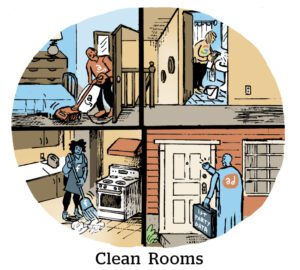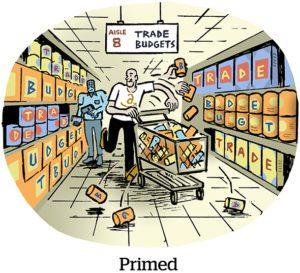Cloud infrastructure vendors are insinuating themselves into data-driven advertising.
Third-party ad tech vendors are becoming service providers that build their solutions using cloud infrastructure – namely Amazon Web Services (AWS), the Google Cloud Platform (GCP), Snowflake and Microsoft Azure.
This trend has given rise to technologies such as data clean rooms and CDPs, and for many major advertisers and ad buyers, the cloud is their post-cookie plan.
If you ask the cloud operators themselves, they might call it the Daft Punk revolution – better, faster, stronger. But the real reason why marketing tech companies are building their businesses on the backs of cloud platforms is privacy.
Still, the question remains: Can this cross-cloud collaboration system function in the real world? As in, to be useful for marketers while also passing muster with regulators and privacy advocates.
Privacy laws and platform data policies have focused on restricting the number of businesses that can access data, rather than prohibiting specific actions like ad targeting or attribution. That’s why Apple’s ATT update derailed Facebook’s ad platform, whereas Amazon Ads kept trucking along despite the post-pandemic ecommerce slowdown. Facebook needed other businesses to share data, whereas Amazon already has the data in one place.
If the new rules of the road call for data to be kept in one place, then the only logical outcome is for vendors to set up shop there.
How cross-cloud collaboration is actually used
One challenge is that ad tech and data vendors have a nuanced understanding of the technology, but clients often don’t.
Last year, a marketer at a large beverage brand told me she had begun running parallel campaigns on The Trade Desk and the Walmart Connect DSP, which is built on The Trade Desk. By reconciling the IDs, she said, the brand can attribute certain media channels to Walmart sales and retarget customers as they moved between Walmart and other stores or publishers.
Wait!
Isn’t that exactly what the Walmart Connect DSP is built to prevent?
Yes, it is.
Cloud-based targeting and attribution generally can’t be audited and don’t enhance the brand’s own customer data. But from the marketer’s point of view, they’re still using familiar dashboards to employ common tactics.
For instance, a walled garden like the Walmart Connect DSP might generate an audience segment that can be retargeted on TikTok, Roku or Snapchat, and then later attributed to purchases. The data might also be put into a clean room where the IDs can be retargeted elsewhere without exposing individuals.
For another example of how cross-cloud collaboration works in practice, consider LiveRamp and the Amazon Marketing Cloud (AMC), which is the data clean room operated by Amazon Ads.
In February, LiveRamp announced a partnership with Amazon so that RampID, LiveRamp’s ID solution, can be used “as a key to join first and third-party insights with Amazon Ads in Amazon Marketing Cloud for measurement and to activate brand-specific RampID-based audiences directly on RampID within Amazon DSP.”
You’re forgiven for not following that jargonese – and if you’re a marketer, this complexity has relatively little impact on your day-to-day work.
Brand marketers don’t need to know the modular arithmetic to explain how two parties can multiply two numbers to reveal a sum without revealing the numbers in the formula.
For LiveRamp and AMC, it’s complicated. They aren’t just matching and enhancing profiles, like during the former days of data onboarding.
Encrypted audiences within Amazon Ads are matched to an encrypted instance of the RampID graph. The Amazon DSP doesn’t know who it’s retargeting or attributing on behalf of the advertiser – all it has is an encrypted RampID. And LiveRamp doesn’t find out who made a purchase, only the aggregate number of conversions. Meanwhile, the advertiser doesn’t know who it retargeted, and no data is added to its first-party CRM system.
But user-level retargeting and purchase attribution did happen.
Ad tech is like a fancy restaurant that, for now at least, is able to maintain normal service in the dining room while chaos and grease fires upend the kitchen.
Potential pitfalls
But back to the main question – will cross-cloud collaboration work?
Well, the fact is, it does work. Billions of marketing dollars are channeling through this system as we speak.
There are caveats, however.
Just last week, a report co-authored by privacy researchers Wolfie Christl and Alan Toner found LiveRamp has a fairly secure system of encryption and one-way data processing, but that “some of these measures are at least questionable” under GDPR.
For instance, LiveRamp customers have their own instance of pseudonymous RampIDs. That means a DSP or identity vendor that uses RampIDs for Hershey’s and Mondelez, say, can’t compare data across its clients. Google puts a similar barrier in place when an agency or ad tech company uses Ads Data Hub, its cloud-based data clean room, on behalf of many brands.
However, Christl and Toner allege that some RampID customers are themselves data brokers, DSPs or SSPs that maintain their own identity systems. They incorporate a pseudonymous RampID into their results and pass those results – even sometimes specific audiences – onto other clients.
LiveRamp’s privacy measures are built to prohibit individuals from being re-identified by advertisers, ad tech or publishers. And the report does acknowledge that LiveRamp does this well.
But what if the law is interpreted to prohibit personal data from being joined across different databases and companies?
There’s nothing stopping a European data protection authority from pursuing that interpretation.
According to some brand marketers (and boastful press releases), brands can track and attribute consumer IDs across cloud infrastructure services and digital media platforms that are each, ostensibly, walled gardens unto themselves.
Which means collaboration software companies should speedily educate clients about how their privacy frameworks work. And they should refrain from over-selling their capabilities.
Because cloud-based ad tech is an advertiser’s best hope for a post-cookie solution. But if data collaboration tech vendors aren’t careful, they’ll be the next problem that needs to be solved.


















